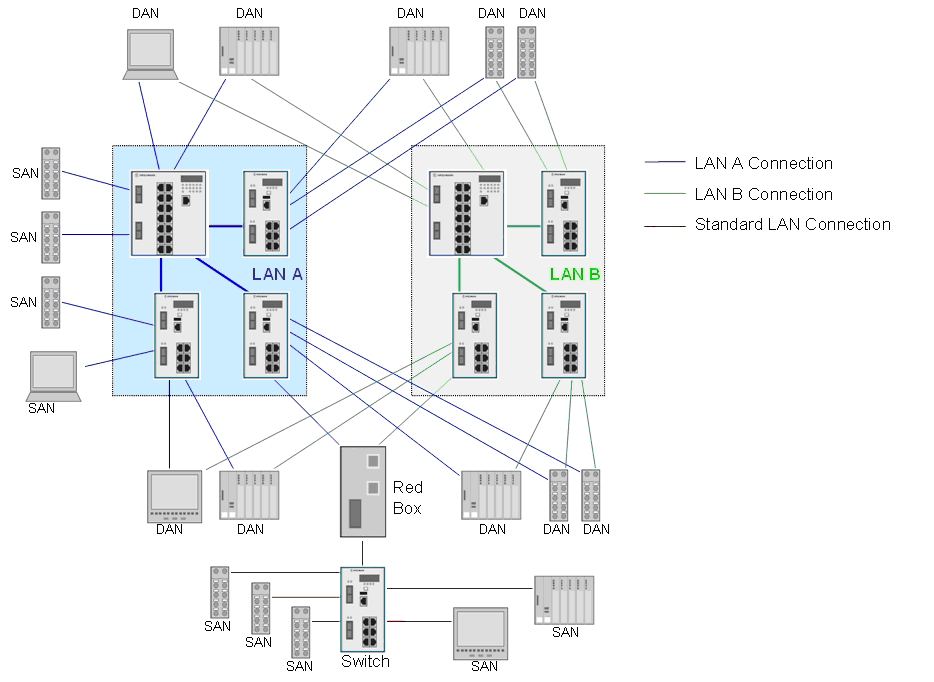Although a fast MRP ring can cover a very large number of requirements, there are still applications that cannot tolerate any switchover time at all.

To fulfill such requirements we need to take an entirely new approach to the question of guaranteed high availability. The basis of this new approach to network redundancy is to have two independent active paths between two devices. The sender uses two independent network interfaces that transmit the same data simultaneously. The redundancy monitoring protocol then makes sure that the recipient uses only the first data packet and discards the second. If only one packet is received, the recipient knows that a failure has occurred on the other path. This principle is employed by the parallel redundancy protocol (PRP), which is described in the IEC 62439-3 standard. PRP uses two independent networks with any topology and is not limited to ring networks.
The two independent parallel networks may be MRP rings, RSTP networks and even networks without any redundancy at all. The principal advantage of PRP is its interruption-free switchovers, which take no time at all to switch over in failure situations and thus offer the highest possible availability. Naturally this applies only provided both networks do not fail simultaneously.
PRP is implemented in the end devices, while the switches in the networks are standard switches with no knowledge of PRP.
An end-device with PRP functionality is called a double attached node for PRP (DAN P) and has a connection to each of the two independent networks. These two networks may have the identical structure or may differ in their topology and/or performance. A standard device with a single network interface (single attached node, SAN) can be connected directly to one of the two networks. Naturally, in this case, the device will have no redundant path available in the event of a failure.
A SAN can alternatively be connected to a redundancy box (RedBox) that connects one or more SANs to both networks. SANs do not need to know anything about PRP, they can be standard devices. In many applications only critical equipment will need a dual network interface and less vital devices can be connected as SANs, with or without a redundancy box.

Network with parallel redundancy protocol
A DAN P implementation controls the redundancy and deals with duplicates.
When the upper layers receive a packet for transmission, the PRP unit sends this frame to the network via both ports simultaneously. When these two frames traverse the two independent networks they will normally be subject to different delays on their way to the recipient. At their destination the PRP unit passes the first packet to arrive to the upper layers, i.e. to the application, and discards the second one. The interface to the application is thus identical to any other Ethernet network interface.
The redundancy box implements the PRP protocol for all the attached SANs and thus operates as a kind of redundancy proxy for all types of standard equipment. Duplicates are recognized by means of the redundancy control trailers (RCT) introduced into each frame by a PRP connection or RedBox. In addition to a network identifier (LAN A or B) and the length of the user data contained in the frame, these 32-bit identification fields also contain a sequence number that is incremented for each frame sent by a node.
A RedBox or DAN P connection can thus recognize duplicates, and if necessary discard them, on the basis of the clearly identifiable features contained in each frame (physical MAC source address and sequence number). Since the RCT is inserted at the end of the frame, all the protocol traffic can still be read by SANs, which interpret the RCT merely as additional padding with no significance. This means that a SAN that is connected to a PRP network directly, i.e. without a RedBox, is able to communicate with all the DAN Ps and with any SANs in the same network (either A or B). It lacks only connections to the nodes of the other network, because a DAN P does not pass any frames from one LAN to the other one. PRP switchover times fulfill the very highest demands, and it is also extremely flexible as regards network structure and possible topologies, but it does always need twice the installed infrastructure of switches and other network components.


